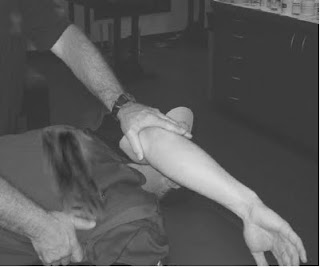The stretches below are primarily to MAINTAIN your range of motion, NOT GAIN range of motion in your shoulder. This is an important concept to grasp. Daily stretching will allow you to achieve the appropriate range of motion over time for the shoulder that is needed to maximise your velocity as well as prevent injury. If you Stretch only before and after games and try to GAIN motion while stretching, you will not be gaining any lasting effect of motion from the stretching and you also will be making yourself susceptible to injury.
The below diagram illustrates the necessary range of motion in the shoulder. The average range of motion needed for pitchers is: external rotation (ER)~120 degrees and internal rotation (IR) ~60 degrees. The important factor is the “total motion” (TM) of 180`. If this range is not maintained then there is an increased risk of injury occurring.
Stretching Techniques
The techniques used most often are a combination of what's called PNF (Proprioceptive Neuromuscular Facilitation) contract-relax techniques.The theory behind PNF stretching can be a bit long and boring for most, but in short it provides a better stretch for two main reasons. The first is when contracting a muscle (either the same or opposite muscle to what you are stretching) during a stretching routine, you are stimulating the nervous system, which causes a reflex inhibition reaction causing the muscle to relax. This allows you to stretch further as the muscle is now more relaxed. The second reason, which is not often talked about, is that by contracting the muscle your are increasing the amount of blood to the muscle, which creates more fluid around the muscle to the supporting fascia (spiderweb-like substance that holds the muscle together), which lubricates it and allows it to stretch further. This second reason is used well in method #2 as it also creates more heat in the muscle, which reduces the risk of injury.
Method #1
The person holds the stretching position for 5-20secs. The assistant (or your other arm/towel/rope) then holds the arm/leg in the stretched position and resists the arm/leg in the opposite direction to that of the stretch. The force given by the person stretching is 20-50% effort. This is held for 3-5secs. The person stretching then moves the arm into a slightly stronger stretch where the whole process is then repeated 3-4 times. With each repetition there should be a slight increase in stretch.
This method is best performed after your game or workout.
Method #2
An alternative to this method, which is more of a warm-up technique is demonstrated by Mark Verstegen in his warm-up/stretching videos (first one below). One of the difference with Mark verstegen's warm-up stretches are they are done with only 2-3 second holds and repeated more than 3-4 times (up to 7-8). The other is he uses the opposite muscle of the one being stretched to hold the stretching position.
(I often add a resistance in the opposite direction as in Method #1 to method #2. Just personal preference as it's a combination of the two)
Stretch #1
Below is a great stretch for the shoulder and maybe the best. The below video does a good job at illustrating the stretch. However, Evidence suggests that the shoulder should not point straight up to the sky as this places to much strain on the shoulder capsule. Instead, let your top shoulder point back at a 45 degree angle. Halfway between the top shoulder laying on the ground to pointing to the sky.
This position stretches into internal rotation of the shoulder.
The remaining pictures aren't the greatest of quality so i will update them when i get a chance. (These are also in no particular order)
Stretch #2
This position stretches the inferior capsule of the shoulder.
This position stretches the posterior gleno-humeral musculature.Lying on your back aids to stabilize the shoulder blade.
Stretch #4
This position stretches into external rotation of the shoulder.
Stretch #5
This position stretches your hip, middle and lower back, and across your chest.This is important for pitchers and improving their trunk rotation flexibility.
Technique: Use your inner thigh (adductor muscles) to hold your knee down with the assistance of your hand.Then reach across your body trying to reach your arm and shoulder flat on the ground. Continue to reach as far as you can while holding (with your inner thigh muscles) your top knee to the ground. Hold this For 3-5secs and repeat 3-4 times on both sides.










